Introduction
Within This Page
Architectural window film is a retrofit product designed to enhance glass performance. It is a polyester film construction generally made of Polyethylene Teraphthalate (PET). Most films are applied to the interior surface of a glass window in a home, commercial building, or vehicle. They have a scratch resistant coating on the outer surface to protect the film.
There are many types of window films. Some are clear and feature multiple layers of PET to offer protection from shattering glass; others are tinted with metals, dyes, or pigments to reduce the visible light transmitted through the glass, and block heat coming through from the sun. There are even decorative window films that can replicate the look of frosted glass or etched patterns.
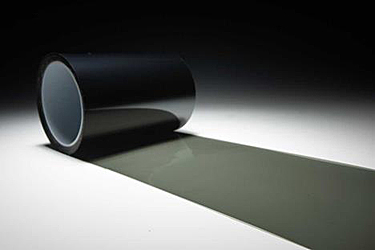
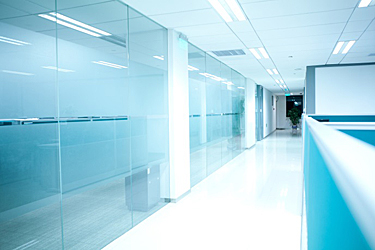
Roll of solar control window film and an office building's interior glass filmed with a decorative product.
Description
Architectural Window Film Uses and Benefits
Window film can benefit residential and commercial spaces in a variety of ways. One of the most popular uses for window film is in climate and energy control. Window film significantly reduces solar heat gain through windows allowing a space to maintain its internal temperature and eliminating hot spots. Hot spots are temperature inconstancies between one part of a building and another and are relatively common. The energy savings also results in reduced HVAC equipment wear and maintenance.
Window film also aides in fade mitigation by blocking damaging ultraviolet rays. Valuable furnishings such as carpets, furniture, and artwork all benefit from the reduction in ultraviolet rays streaming through the home or office windows.
Annoying glare can also be controlled through the use of window film. Window film is a popular choice in many homes and office buildings where certain areas of the space are prone to strong glare from the sun making it uncomfortable to work or relax.
Buildings with dated looking windows can benefit from window film. The installation of film is an inexpensive and easy way to improve the overall aesthetics of a building or residence.
Decorative window films allow easy retrofit of existing glass with an array of patterns to compliment any décor. With decorative film the distinctive look of etched glass can be achieved at a fraction of the cost of actual etched glass. The designer films also allow private, interior glass spaces to be created while still welcoming in light.
Safety and security film products protect a building's occupants from the hazards of flying glass by holding glass shards in place in the event of a window breaking, preventing serious injuries.
Common Architectural Window Film Applications
Common applications include homes, commercial buildings, retail spaces, restaurants, museums, schools and daycare centers and health care facilities, and more. (See WBDG Building Types and Space Types)
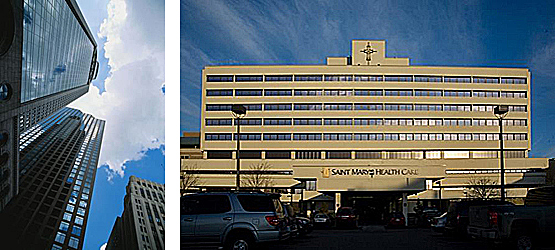
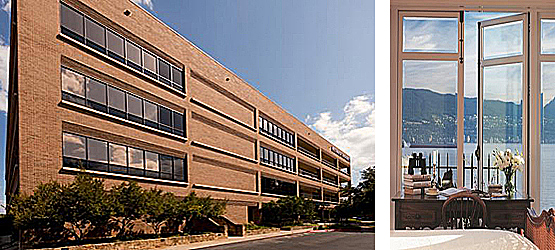
Common applications include: skyscrapers and hospitals/medical centers, residences and office buildings.
Window Film Fundamentals
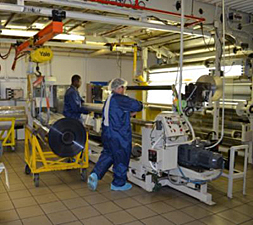
Manufacturing Window Film
Quality window films are high-tech and feature a variety of high-performance attributes. These features include patented scratch resistant coatings, sputtered coatings, or vacuum metallization, and nano-particle pigmentation.
Window film is designed with longevity in mind. Many window film manufacturers offer a warranty of up to 15 years for commercial installations, and for as long as a person owns their home for residential applications. The effective life of window film will vary by the type of film, type of glass, window construction, compass orientation of glass, and in which part of the world the building is located.
Window Film Technology - Components
The performance and durability of the window film selected is determined by the types and quality of the components and construction used.
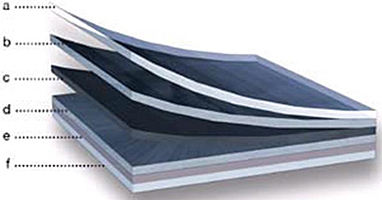
Layer C may have added UV inhibitors for extended durability. Source: EWFA, "An Introduction to Window Film Technology," 2005
The essential components include:
a = release liner with silicone coating b = adhesive layer with UV inhibitor c = clear or tinted polyester film d = adhesive layer e = metallized layer for heat rejection on clear polyester film f = scratch-resistant coating
Protective Release Liner — a film, usually polyester, which is used to cover the adhesive and protect it from contamination before installation
Adhesive — high quality, low or zero distortion adhesives that adheres the polyester film to glass; types used for automotive installations retain high adhesion even on double curved glass
Polyester Film — a strong, high clarity, high quality plastic film - more than one layer may be used with a laminating adhesive to produce a multi-layered structure
Scratch Resistant Coating — a hard acrylic coating that provides protection for the polyester against scratching and abrasion
Dyes, metals, alloys and UV inhibitors are added to produce the specific properties desired.
Window Film Technology - Manufacturing
The film manufacturing processes consists of five main processes, each requiring care to ensure the highest quality is obtained.
- Coating
- Laminating
- Metalizing or
- Sputtering
- Coloring
Coating: Material is transferred from a container onto a large roller, then from the roller onto the surface of polyester film. Examples include scratch resistant surfaces and adhesives.
Laminating: A film coated with adhesive is adhered to a second uncoated film, using a roller system to press the two films together.
Metallizing: A roll of polyester film is wound round a water-cooled roller in a large metal chamber, and the air is pumped out to produce a vacuum. A metal, usually aluminum is evaporated onto the cold surface of the film; very few metals evaporate in a vacuum so sputtering is used for other metals. Metallizing is a fast process compared to sputtering.
Sputtering: Equipment very similar to metallizing is used, but a metal or alloy target is bombarded with positive ions to knock (sputter) atoms of metal out of the target and onto the cold film surface. A large number of different metals and alloys can be sputtered. Metals used in sputtering, such as Nickel, can also have extra resistance to corrosion.
Coloring: Colors may be added to the adhesive before coating onto the polyester (as above) or the polyester film may be deep dyed. The color produced is usually a mixture of different dyes; in general, better durability is obtained using deep dyeing processes.
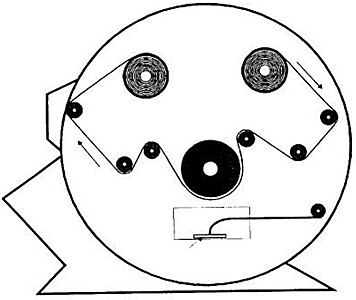
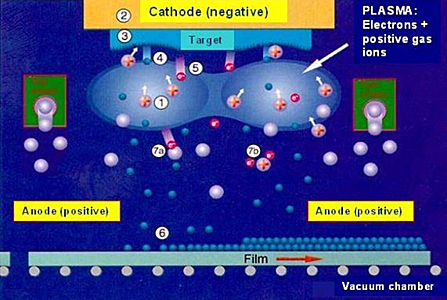
Metallizing of Polyester (PET) film vs. Sputtering of Polyester (PET) Film Source: EWFA, "An Introduction to Film Technology," 2005
Understanding Solar Optical Properties
The five key measurements to consider when selecting a window film are visible light, visible light — transmitted, visible light — reflected interior, visible light — reflected exterior, and the Solar Heat Gain Coefficient (SHGC). Understanding all of film's solar optical properties will help designers, property owners, and homeowners be better informed regarding the product that will best meet an individual property's unique needs.
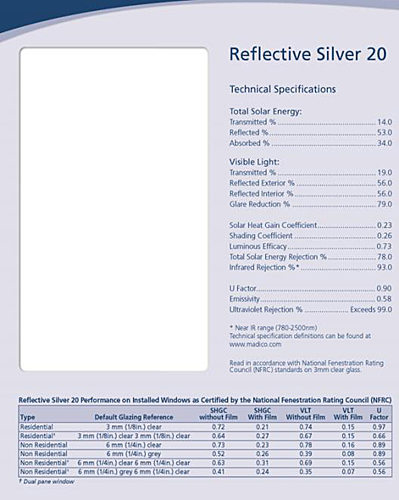
Guide Showing the Solar Optical Properties of a Film
Total Solar Energy: all the energy in the solar spectrum that reaches us on the earth's surface. This includes UVA and B, Visible light, and Infrared energy up to roughly 2500nm. Heat often refers to the total solar energy.
Total Solar Energy: Transmitted: the amount of total solar energy that passes through the glass into the building.
Total Solar Energy: Reflected: the amount of total solar energy that is reflected off of the glass and directed back outside. This energy does not come into the building.
Total Solar Energy: Absorbed: the amount of total solar energy that is absorbed in the glass. This heats up the glass, making it hotter to the touch, and reradiates a small amount of heat back into the room. The majority of absorbed energy is kept out of the room though.
Visible Light: the portion of the solar spectrum containing visible light we can see, from roughly 370nm up to 770nm, contains all the colors of the spectrum.
Visible Light - Transmitted: the amount of visible light that passes through the glass, into the building. This is how light or dark the film is.
Visible Light - Reflected Interior: the amount of visible light that is reflected off the interior surface of the window. This is seen when standing inside the building looking out. A higher reflectance value means the window looks more like a mirror from the inside.
Visible Light - Reflected Exterior: the amount of visible light that is reflected off the exterior surface of the window. This is seen when standing outside the building, a higher reflectance value means the window looks more like a mirror from the outside.
U Factor (winter): heat transfer due to temperature differences outside and inside. It represents the amount of heat passing through 1 sq. ft. of glass in 1 hour for every 1 degree temperature difference between the outside and inside. A lower value means less heat passes through, this is generally of interest when desiring to keep heat inside the building in cold climates.
Emissivity: the ability of the surface to reflect infrared energy. For window film, this means how much heat it will reradiate back into a room. Low E glass and films have low emissivities, which mean they reflect a lot of heat back into the room, which is the desired effect in cold climates.
Ultraviolet Light Rejected: the amount of UV energy blocked by the film, either by reflecting or absorbing it. This energy does not enter the building.
Glare Reduction: the reduction in visible light transmitted compared to clear unfilmed glass.
Luminous Efficacy: the ratio of visible light transmission to solar heat transmission for a window. A higher luminous efficacy means the film has high heat rejection given its VLT.
Shading Coefficient: the ratio of heat passing through a filmed window to heat passing through clear, unfilmed glass. A lower number means better heat rejection.
Solar Heat Gain Coefficient: similar to the shading coefficient, except this value also takes into account energy that is reradiated back into the room from the glass heating up due to increased absorption. Again, a lower number means better heat rejection. It is the primary indicator of a film's effectiveness in rejecting solar energy.
Infrared Rejection: the amount of infrared (IR) energy that is blocked by the film, either by reflecting or absorbing. This value is for the whole IR region of the solar spectrum, roughly 780nm up to 2500nm.
Total Solar Energy Rejected: the total amount of solar energy that is kept out of the building. This is commonly referred to as heat rejection.
The Global Energy Environment
According to the World Business Council for Sustainable Development (WBCSD), 40% of global energy is consumed by commercial buildings. Roughly 1/3 of the power consumption of a commercial building is due to excess load placed on HVAC systems due to solar heat gain.
High efficiency window films can reduce Solar Heat Gain by 50–75%, often without making a drastic change in aesthetics from either the interior or exterior view; unless you choose to in order to reach a specific objective. Window films help to manage Solar Heat Gain by controlling the transmission, absorption and reflection of solar energy.
It's a simple equation, if the heat is kept out of the box then less energy is spent to cool the box. Or the transverse, in the winter, control heat loss with high efficiency window films.
Solar Energy Management 101
Think of window film as a filter, reflecting or absorbing much of the heat produced as well as other damaging elements of solar energy such as Infrared Light and Ultraviolet Light.
Both UV and IR are invisible to the human eye so blocking these has no impact on desirable visible light through a window. While allowing portions of the more desirable visible light to pass through; energy control window films can capture or control the damaging UV and IR light and filter the visible light to a desirable level.
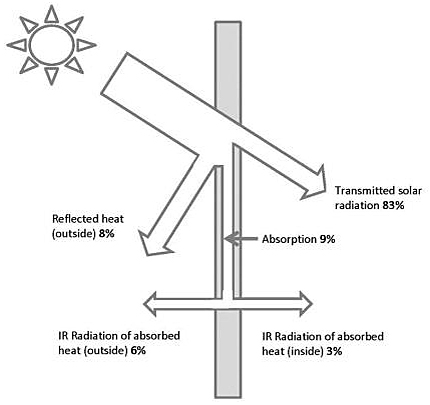
Transmitted - Reflected - Absorbed Diagram
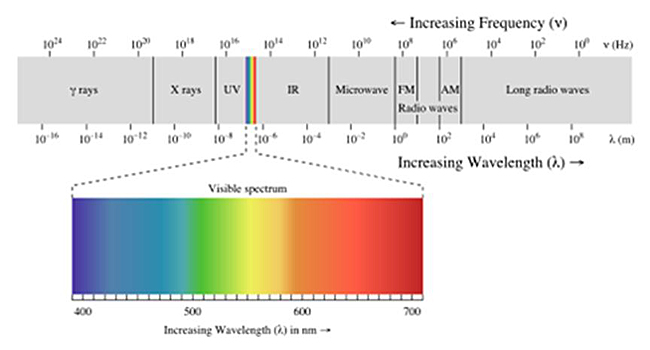
Visible Light Spectrum Wavelength
Retrofit and New Construction
Window film as a retrofit solution can be one of the quickest and simplest ECM's (energy conservation measures) available, as well as the most cost effective. In regard to new construction, window film can be used as an energy control boost to glass performance and/or to achieve a desired look.
How Window Film Reduces Fading
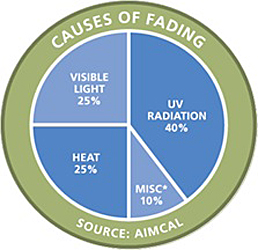
Causes of Fading Diagram
There are six factors affecting fabric fading:
- Ultraviolet Light
- Visible Light
- Heat and Humidity
- Chemical Vapors (including ozone)
- Age of Fabric
- Dye Fastness
Clear single pane glass (1/8" to 1/4") will reject 23–28% of the ultraviolet light from the sun. Insulated glass is slightly better, rejecting 36–41%. Window films installed on glass reject 95–99% of solar ultraviolet light. Different types of clear glass and window systems will reject 13–29% of the solar heat. With window films, 80% solar heat rejection can be obtained.
No window film can eliminate fading. It can, however, offer maximum protection from fading due to solar ultraviolet light and solar heat. (Source, IWFA, OnlineDownload FAQs.aspx)
Energy Saving and Conservation
The cheapest, cleanest, most environmentally conscious energy on the planet is the energy that doesn't' have to be used. The three biggest areas of opportunity for conserving energy in a building are: HVAC, lighting, and the building envelope.
Most companies start with lighting because it is quick, easy, and typically cost-effective. The envelope is the most often overlooked opportunity to save energy and money. As simple as it sounds, turning off a light, not making unnecessary trips, and filming windows are simple, cost-effective, and passive ways to conserve energy and offset greenhouse gas emissions.
Building Certification Programs
Some of the major commercial building certification programs operating in the U.S. are — ENERGY STAR by the U.S. Dept. of Energy, LEED (Leadership in Energy & Environmental Design) by the U.S. Green Building Council (USGBC), and GreenGlobes. Window film can help improve a building's score in these programs and can even be the deciding factor that allows a building to become certified.
ENERGY STAR Building Certification
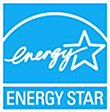
The ENERGY STAR Building Certification score uses a 100 point rating scale. The score is based on four criteria - utility consumption, building type, building size, and building location. A score of 75 is required for certification. The scale is used to rate how efficient a building is compared to similar buildings around the country.
A building's score can vary considerably and the effects of window film can be large or small. A window film that reduces electric consumption by 10% annually can add 6 points to a building's ENERGY STAR score in Boston and 8 points to a building in Los Angeles. It is difficult to predict what the improvement score will be, but it can be significant enough to push a building past the 75 point minimum for certification and also open up more available points in LEED certification, as outlined later.
How Does Window Film Gain Points for LEED Certification?
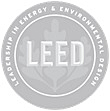
Solar control window film can gain points in the following three categories for LEED Certification — Energy and Atmosphere — Optimize Energy Efficiency Performance (1–18 points, earn same number of points as gained in building's Energy Star score), Indoor Environmental Quality (1 point), and Daylight and Views (1 point).
NFRC Certification for Window Film
Window film is now certified by the National Fenestration Rating Council (NFRC). The NFRC is a nonprofit organization that administers the only uniform, independent rating and labeling system for the energy performance of windows, doors, skylights, and attachment products.
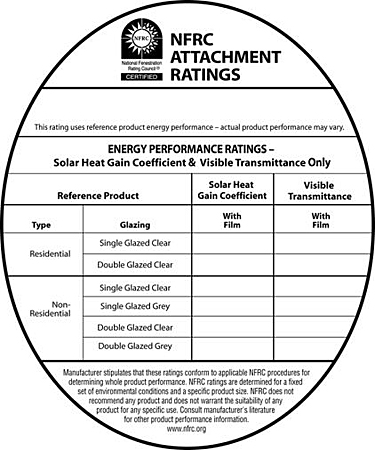
Energy Analysis Programs
There are a three energy analysis programs that are used in conjunction to assist in determining the energy savings available for a specific building—Optics, WINDOW and Efilm.
Optics is a program that accesses the International Glazing Database (IGDB). The IGDB is a repository of all the NFRC glazing, glass, and film information. This program is used to create film and glass combinations that can then be used in "WINDOW" to add frames, dividers, and gases to model a window. Windows created in "WINDOW" are then utilized in the Efilm energy analysis software program.
What is Efilm?
Efilm is a software program specially designed for the window film industry. It analyzes how energy consumption changes with the addition of window film.
The software runs on the Department of Energy's EnergyPlus 8.0 simulation engine. It is similar to eQuest and was commissioned to be developed by the International Window Film Association (IWFA) and several major window film manufacturers.
Efilm creates a 3D model of a building, using defined building parameters such as:
- Size, shape, age of the building
- Type of building
- Location and annual weather patterns
- HVAC systems
- Lighting, occupancy, equipment loads and schedules
- Hot water usage
- Exterior and interior building construction
- Daylighting controls
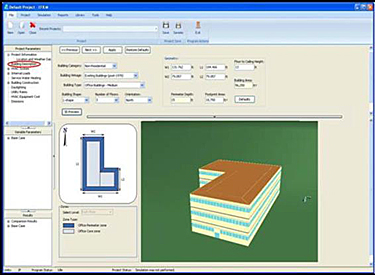
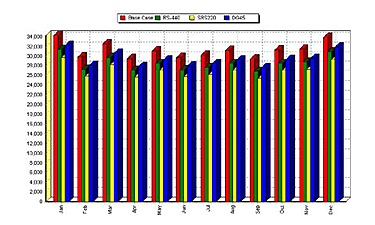
Example of 3D Modeling Using Efilm
Graph of Electric Costs for a Building
Window Film and Safety and Security
Safety and security window films have been tested to perform against many recognized standards such as basic personal safety ratings like ANSI Z97.1 to large scale blast mitigation (GSA).
ANSI Z97.1 is a standard that establishes the specifications and methods of test for the safety properties of safety glazing materials (glazing materials designed to promote safety and reduce the likelihood of cutting and piercing injuries when the glazing materials are broken by human contact) as used for all building and architectural purposes.
GSA-TS01-2003Download Standards_GSATestingStandard.pdf , takes it further by standardizing blast pressure testing. This test standard is intended to ensure an adequate measure of standardization and quality assurance in the testing of window systems including but not limited to glazing, sealants, seats and seals, frames, anchorages and all attachments and/or secondary catcher or restraint mechanisms designed to mitigate the hazards from flying glass and debris. This standard is the sole test protocol by which blast resistant windows and related hazard mitigation technology and products shall be evaluated for facilities under the control and responsibility of the US General Services Administration (GSA).
Safety and security films can improve all glazing types in blast mitigation. Annealed, tempered, and even laminated glass can be unsafe when subject to a blast. Safety film can be attached to the glass and also, if needed, to the frame to retain the film/glass combination, preventing glass from entering the building.
Safety and security films have been protecting human lives against accidental and intentional injury since their inception in the 1970's. They offer protection from criminal intrusion, natural disasters, man-made disasters, industrial accidents, bomb-blasts, burglaries, and more.
Case Study 1 - Building Modernization
The Challenge: 1960's Sarasota, FL building's exterior needed to be modernized. The building featured rows of dark green vision glass, between rows of opaque green spandrel glass, creating a dated look.
The Solution: 38,000 sq. ft. of glass was filmed with an exterior grey film, creating a more modern, cohesive look.
The Results: The building looks 30 years younger and electric consumption was reduced by over 200,000 killowatt hours each year, saving thousands in cooling costs.
Case Study 2 - Improved Comfort
The Challenge: A restaurant located in an arena, and featuring a 4,603 sq. ft. wall of glass, was experiencing occupant discomfort due to hot spots and glare.
The Solution: A solar control film that matched the existing windows in other parts of the arena was applied to help regulate the temperature and reduce glare.
The Results: Diners no longer request to be reseated, saving the staff time and increasing the overall efficiency of the restaurant.
Case Study 3 - Safety & Security
The Challenge: A hospital needed to find a way to offer its patients protection from flying glass in the case of a natural or man-made disaster as well as protect its millions of dollars' worth of state of the art medical equipment from damage.
The Solution: 15 and 8 mil film was installed along with various attachment systems to meet the hospital's varying requirements. The film is designed to hold broken shards of glass together and along with the attachment systems, provides 24 hour protection against vandalism, severe weather, acts of terrorism and industrial accidents.
The Results: With the added layer of safety at the facility, staff members no longer need to spend time relocating patients when a threat is near because they know the windows are secured. This is especially important for patients on the intensive care floors and unable to be safely moved. The hospital's valuable medical equipment is also now better secured through the protection of the windows.
Relevant Codes and Standards
- Energy Policy Act of 2005
- Energy Star® Windows
- National Fenestration Rating Council (NFRC) Certified Products Directory—Contains performance characteristics for window assemblies from most manufacturers.
Additional Resources
Associations and Organizations
- American Architectural Manufacturers Association (AAMA)—Trade association of firms engaged in the manufacture and sale of building fenestration components and related products.
- Efficient Windows Collaborative—Provides information on the benefits of energy-efficient windows in houses throughout the US. This site is sponsored by the U.S. Department of Energy.
- Florida Solar Energy Center-Fenestration Research Group—This group studies the performance of fenestration systems. The main focus is on solar heat gain and its effects on energy costs for heating and cooling.
- International Window Film Association—A unified industry body of window film dealers, distributors, and manufacturers that facilitates the growth of the window film industry by providing research, influencing policy and promoting awareness of window film.
- National Fenestration Rating Council (NFRC)—A non-profit public/private collaboration of manufacturers, builders, designers, specifiers, code officials, consumers, utilities, and regulators working towards a national energy performance rating system for fenestration products.
- National Glass Association
Design and Analysis Tools
Window Properties
- Energy Star® Windows
- Usually, the physical properties of glazing systems are easily obtained from product literature and certified by the National Fenestration Rating Council (NFRC).
- WINDOW5.2 or latest version, a federally funded computer program developed by Lawrence Berkeley National Laboratory (LBNL), calculates U-values, SHGC, and Tvis of window systems constructed from glass and frames of known properties.
Window Design Strategies
- Commercial and Institutional—To analyze the effect of different window areas and glass properties, investigate:
- Computational Fluid Dynamics (CFD)—This advanced computer-based analysis method can help analyze the effects of complex fenestration systems on air currents and interior ventilation patterns. For more information: CFD Online
- DOE–2.1—An hourly building simulation software designed to analyze, complex, multi-zone buildings. Availability: Simulation Research Group, Lawrence Berkeley National Laboratory.
- PowerDOE—Similar to DOE–2 with a Window's interface. Availability: DOE2.com
- Skylight Handbook—A hand calculation method for optimum skylight design developed by Lawrence Berkeley National Laboratory (LBNL). Distributed by AAMA (Product Code SHDG-1-88).
- VisualDOE—Similar to DOE-2 with a Window's interface. Distributed by Charles Eley Associates.
- Residential—To analyze the effect of different window areas and glass properties, consider:
- Guidelines for Home Building with BuilderGuide software—This is a simple computer software tool for evaluating the solar savings fraction of a building design. Availability: Sustainable Buildings Industry Council (SBIC).
Other
- GSA Sustainable Facilities Tool (SFTool)—SFTool's immersive virtual environment addresses all your sustainability planning, designing and procurement needs.
Manufacturers of Window Film Products
- 3M — Manufacturer of solar control, safety and security, automotive and decorative window film solutions.
- Eastman Chemical Company Advanced Materials – Performance Films — Manufacturer of solar control, safety and security, automotive and decorative window film solutions.
- Hanita Coatings — Manufacturer of solar control, safety and security, automotive and decorative window film solutions.
- Johnson Laminating & Coating Inc. — Manufacturer of solar control, safety and security, automotive and decorative window film solutions.
- Madico, Inc. — Manufacturer of solar control, safety and security, automotive and decorative window film solutions.
- Saint-Gobain Solar Gard LLC — Manufacturer of solar control, safety and security, automotive and decorative window film solutions.
Publications
- ASHRAE Handbook of Fundamentals by American Society of Heating, Refrigeration, and Air-Conditioning Engineers (ASHRAE). Atlanta, GA, 2013.
- Glazing Handbook for Energy Efficiency by The American Institute of Architects (AIA). Washington, DC, 1997.
- Residential Windows: A Guide to New Technologies and Energy Performance by John Carmody, Stephen Selkowitz, Dariush Arasteh and Lisa Heschong. New York: W. W. Norton & Company.










